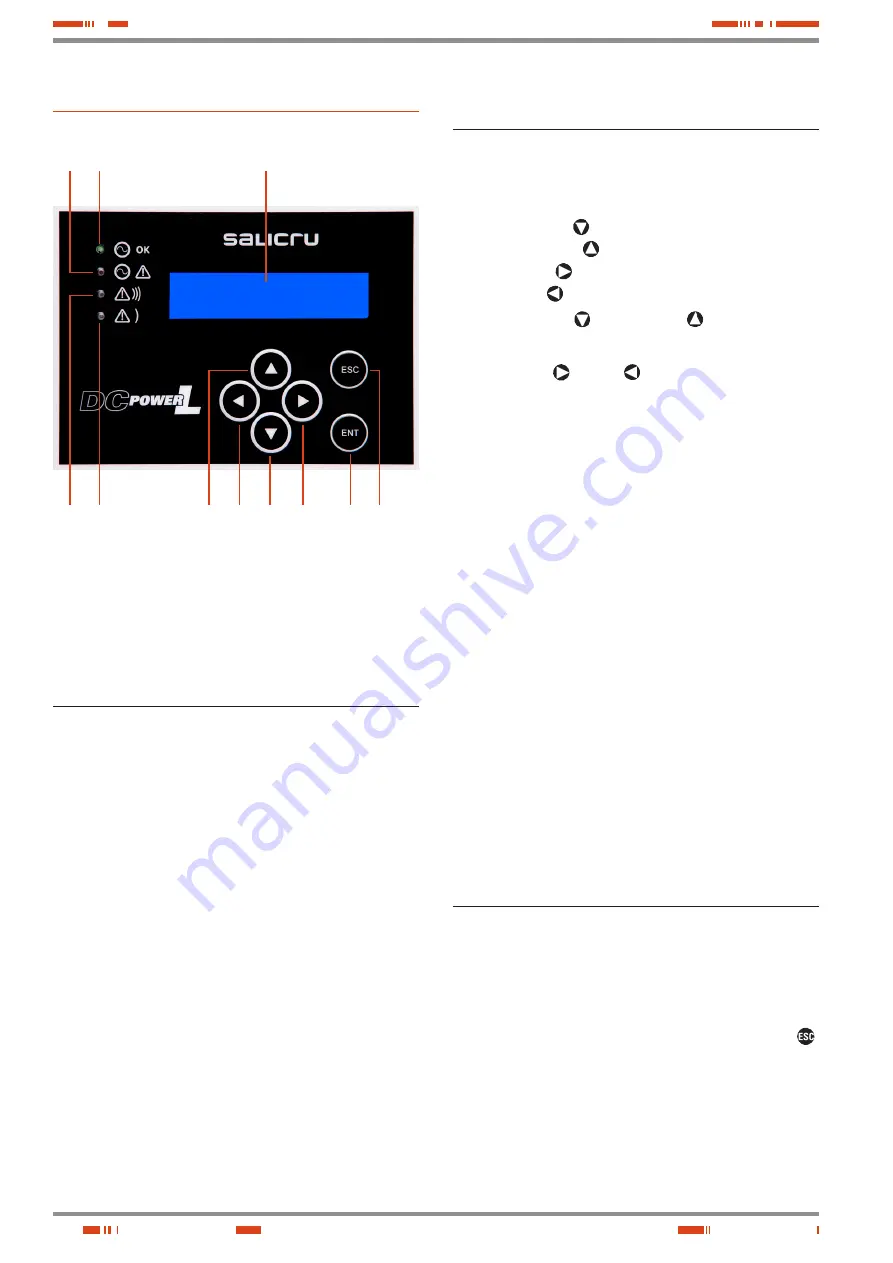
22
9.2. Basic functions of the keys and
notes of interest.
(e)
LCD display.
(f)
‘
ENT
’ key.
(g)
‘
ESC
’ key.
(h)
Forward key ‘
’.
(i)
Backward key ‘
’.
(j)
Right key ‘
’.
(k)
Left key ‘
’.
•
Use the forward ‘
’ and backward ‘
’ keys to access the
screens of the root menu and be able to freely move from one
to another with them.
•
Use the right ‘
’ and left ‘
’ keys to move inside each sub-
menu.
•
The ‘
ENT
’ key has two functionalities:
Entry to sub-menus.
Recognition of an alarm.
•
The ‘
ESC
’ key enables you to return directly to the home
screen just by pressing it, regardless of where you are.
•
On the screen map of Fig. 9, all of the sub-menus are blown
up, including those that are ‘Password’ protected. Take into
account the following annotations:
All of the screens include numbering located bottom
right, as a reference for later description or clarification.
The Password hidden screens have a second annota-
tion, located bottom left. This level of security prevents
unauthorised personnel from tampering with any setting
or programming.
On some screens, the maximum number of characters
that the numerical or alphanumeric values shown on it
can acquire are represented by an ‘x’, each of which cor-
responds to a digit.
•
It is not anticipated that the user can modify the factory set-
tings, so the ‘Password’ is not supplied to enter on Screen 6.1
by specific requirements of the customer.
Even so, on the screen map of Fig. 9 the whole map is blown
up.
If you require a modification or adjustment, contact our Tech-
nical Service and Support
(T.S.S.)
.
9.3. Description of the screens.
9.3.1. ‘Home’ screen menu.
Screen 0.1
This is the main screen of the system which appears when the
device starts up. It is also the screen that appears when
( )
is pressed to exit any of the other menus or sub-menus of the
control panel with LCD.
The first line shows the voltage and output current of the device
and the second line shows the current battery charging mode,
which can be any of the following:
•
BATT. DISCHARGE: The batteries are discharging.
•
BATT. FLOAT: The batteries are in float mode.
9. Control panel.
(b) (a)
(e)
(c) (d)
(i) (k) (h) (j)
(f) (g)
Fig. 8.
Control panel with LCD.
•
The control panel basically consists of the following parts:
LED optical indications.
LCD of 2x16 characters.
Keypad consisting of 6 keys.
9.1. Optical indications and alarm.
The optical indications (LEDs) of the synoptic illuminate when the
alarm or state in question is activated.
(a)
Correct output indication: Device output within correct
working range. In the event of incorrect output voltage,
this indication will turn off.
(b)
Input fault indication: Input fault indication (both in single-
and three-phase devices). This includes the trip alarm of
the circuit breaker of the alternating supply or its absence.
(c)
Urgent alarm indication: This groups the blown fuse,
charger fault and output fault alarms.
(d)
Non-urgent alarm indication: This groups the low electro-
lyte level and earth in battery alarms.
Optical indications
(b)
,
(c)
and
(d)
are also supplied as alarms,
through the interface relays (see user manual EN030* of the
communications module).
The device also features an audible alarm that is activated with
any of the alarms that can be seen on the LCD screen. The
alarm is inhibited when it is acknowledged, that is, by pressing
key ‘
ENT
’ for each alarm activated.
It is not possible to generally and permanently mute the audible
alarm.
USER MANUAL
Summary of Contents for DC POWER-L Series
Page 2: ...2 USER MANUAL...
Page 31: ...31 SALICRU...

























